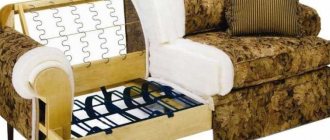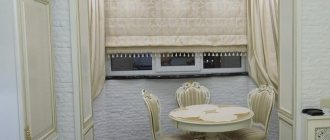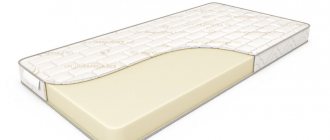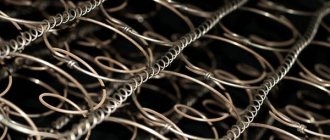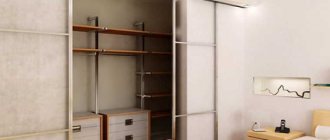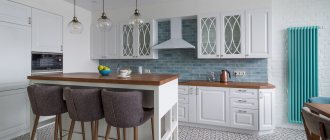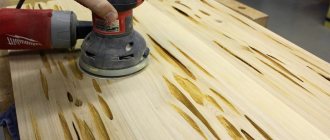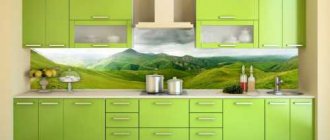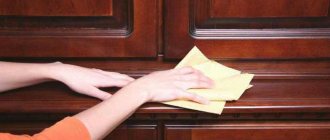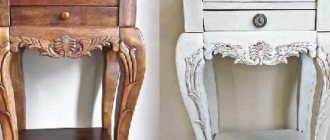Postforming is a technology for laminating chipboard or MDF boards. As a result, it is possible to obtain a super-durable material that is used for the manufacture of countertops and kitchen facades.
The manufacturing process involves treating the surface of the fiberboard in three layers:
- base layer - kraft paper impregnated with resins. It is a connecting element for strong adhesion of subsequent layers;
- decorative layer – plastic.
It is he who determines the future design of the countertop. For example, it can be ordinary, plain, wood, or natural stone.
To process the prepared base, the plastic is heated and, as it were, curved around the surface of the slab.
Therefore, a postforming tabletop can be distinguished in appearance by its characteristic rounded edge.
Wood-look postforming tabletop Getalit BB 924 (Germany):
What types of countertops are there?
Furniture in the kitchen should not only be beautiful, but also comfortable, functional and practical. The countertop is one of the integral components of the kitchen environment. It is important that it is also of high quality and durable, because it is on it that most manipulations are performed.
Let's look at what types of countertops there are. The canvas for covering kitchen cabinets is made from various materials, for example, such as:
- natural and artificial stone;
- tree;
- chipboard (chipboard);
- medium density fiberboard (MDF);
- metal;
- concrete.
What material to choose for the countertop is purely a matter of taste
The choice of material for the countertop directly depends on your taste and financial capabilities, since products made from stone and wood are:
- the most practical;
- durable;
- durable;
- but also the most expensive.
Products made from MDF are in the mid-price range. The most budget option, but also the most common and popular, would be a countertop made of chipboard.
It is very important for the countertop that it is moisture resistant and resistant to damage. Therefore, when purchasing an inexpensive chipboard product, it will be useful to learn about postforming technology.
The countertops must be moisture resistant and highly resistant to damage.
Postforming countertops: manufacturing technology, varieties and materials used
The issue of kitchen arrangement often becomes a stumbling block for homeowners even at the renovation stage. However, with the completion of the renovation work, the owners’ worries do not end.
The time comes to select the most comfortable furniture and household appliances. Most often, the choice falls on a tabletop made of MDF or chipboard with postforming processing (you can see an example in the photo).
To better understand why this type of covering for furniture and other interior objects is so convenient, read more about its features.
What is postforming
The concept of postforming is quite broad. In addition to the fact that this is the name of the technology itself, it can also include any chipboard and MDF products made using this method.
Postforming technology is a method of covering products made of chipboard or MDF with a laminated film, which is plastic consisting of several layers. Using this technology, plastic is heated to a temperature of 220 degrees and the base of the future product is covered under high pressure. The coating on the slab has no seams, which means that the product is less vulnerable to external factors.
Paper impregnated with special resins turns into plastic that reliably covers the tabletop
The laminated film, which covers the surface of the product, as already mentioned, consists of three layers:
- durable base consisting of several layers of kraft paper, which is impregnated with synthetic resins;
- a layer of paper with a pattern that performs a decorative function;
- a layer that protects the tabletop from moisture and damage, consisting of paper impregnated with acrylic and melamine resins.
Decorative coating using this technology can be designed in any style, color scheme and absolutely any ornament. Everything that the customer’s imagination is capable of can be accomplished in production. In construction hypermarkets you will find laminated countertops in standard colors, most often they are plain or imitate marble, wood, or granite.
The last layer of the tabletop is protective
The last, protective layer, protects the surface from various mechanical, chemical damage and moisture on the chipboard base. The layer, for example, will withstand accidental contact with a fork or knife, will tolerate non-aggressive cleaning agents, spilled tea, coffee and juices will also not cause harm. But still, you should not experiment, and you need to take care of the product in a timely manner, especially if you spill substances such as hydrogen peroxide, coloring compounds, and glue. Despite the fairly good wear resistance, it is still not recommended to cut with a knife directly on the countertop. After all, any surface, if treated carelessly, will sooner or later lose its quality and appearance.
The tabletop needs a drip tray so that it drains moisture from its surface more efficiently.
Postforming also has an “Achilles heel”, namely the side opposite the laminated one. It is covered with simple kraft paper, which in no way protects the product from moisture or damage, so any liquid spilled on the surface should be wiped up immediately to avoid getting on the back of the tabletop.
Prices for various types of countertops for kitchen units made of chipboard
Kitchen countertop made of chipboard
How to choose and care for a countertop
Durable and beautiful postforming countertops are well suited for the kitchen and differ from each other in certain properties. How to choose the right material?
The red tabletop looks original.
- The thickness of both the tabletop itself and the plastic on it is of great importance - the thicker the better.
- For the kitchen, it is better to choose matte surfaces; stains will not be visible on them.
- Overly bright countertops will begin to irritate over time.
Unfortunately, such a tabletop will not withstand prolonged exposure to moisture and high temperatures.
Postforming surfaces are very undemanding in terms of maintenance - it is important to wipe them free of moisture and wash them with soap and water.
After completing the procedure, you can polish the countertop.
Types of countertop cladding
There can be two types of cladding for the base of the tabletop:
- 90 degrees;
- 180 degrees.
Postforming 90 degrees involves facing the product only on two sides, which are located at right angles to each other - this is the surface itself and the front end. This method has a significant drawback - the absence of a drip tray. That is, if water gets on the countertop, then pouring down, it will wet the lower surface of the product, which is extremely undesirable, because, as you know, chipboard is a material that is afraid of moisture. Therefore, it is necessary to treat the bottom joint of such a countertop with a silicone-based sealant.
Drip tray on the countertop
Postforming 180 degrees implies that the surface of the tabletop, the end and a short distance of the bottom side are lined with plastic in a U-shape. This creates the opportunity for spilled drops to collect and flow onto the floor without falling on the unprotected base of the product.
Tabletop materials
If the issue with plastic is resolved, then the question remains of a suitable material for the facades and the base of the furniture. Here, manufacturers offer not the largest, but quite simple choice - chipboard and MDF boards, depending on the chosen style of the future kitchen. Restrictions on the use of a particular resource are explained by their physical properties:
- Chipboard slabs are distinguished by a strong monolithic structure that does not lend itself to deformation and is excellent for designing interior objects with strict and smooth surfaces without any design excesses.
- MDF panels are used in the opposite cases, when the client prefers softer forms of tabletops and other types of furniture. Such slabs obediently bend at almost any angle, allowing the owner to realize many artistic ideas and designs.
The processing of each type of material includes a rough coating of resin croft paper, whose main purpose is to create a sufficiently adhesive surface for subsequent adhesion to the decorative layer. It also consists of colored paper, which is responsible for the appearance of the furniture.
Protective resins from the same acrylic are applied on top of it, which after hardening create a fairly durable and transparent lining.
What sizes are there?
It is worth knowing that manufacturers have the opportunity to produce tabletops of different, non-standard sizes, it depends on the wishes of the customer. The maximum length can reach 4 m. But basically, in stores you will find two standard sizing options:
- length – 305 cm, width – 62 cm;
- length – 224 cm, width – 60 cm.
The thickness of the tabletops can be 28 and 38 mm.
In this case, all countertops will be covered with laminated film on only two sides - the working surface and the front end. The side and rear edges remain unprocessed. This is done so that during the installation of the product the master can file it, if necessary, or add it using a connecting strip. In any case, upon completion of the installation of the tabletop, its edges are covered with edge strips.
What are the options for countertops?
Pros of technology
Homeowners often choose post-formed furniture for the kitchen because of its low cost. Experts value the technology for its design versatility. In addition to this, it has other advantages:
- Resistance to aggressive environments - soot, dust, moisture, cleaning agents and detergents. Waterproof properties allow you to use postforming even in the bathroom.
- Resistance to mechanical abrasion and damage from sharp objects.
- Heat resistance of postforming. In places near the stove, a high-quality countertop will not swell the coating, and a hot kettle will not burn out a dark circle.
- Environmental friendliness of the material. The paper base of the plastic is safe for the health of the inhabitants of the house.
- A huge range of colors and textures for the tabletop. You can choose glossy or matte surfaces and easily fit the set into the style of the kitchen.
- The versatility of the material. In addition to the table, postforming is used for canopies, shelves and other interior accessories. Where necessary, the material can be bent and distorted into shape. For example, for facades, a headset.
Advantages and disadvantages of postforming countertops
Like any product made using postforming technology, countertops have their own advantages and disadvantages. Using the table as an example, we will consider the positive and negative aspects of the most common type of kitchen surface, made of particle board.
Table 1. Advantages and disadvantages.
| Advantages | Flaws |
| 1. Affordable price due to low-cost manufacturing technology and inexpensive materials used. 2. Huge palette of colors. The ability to choose any color and print is achieved due to the fact that absolutely any design can be applied to the decorative layer. 3. Sufficiently high wear resistance of the surface is achieved precisely thanks to postforming technology. 4. Over time, the surface pattern does not wear off or fade. 5. Not afraid of elevated temperatures. This does not mean that you can place hot dishes from the stove on the surface, but postforming will easily withstand proximity to the hob. 6. The countertop is easy to care for; it can be easily washed using any dishwashing detergent. | 1. Postforming countertops are manufactured only straight. If you need a U-shaped or corner one, you will have to join several tabletops, cut to the dimensions you need. 2. The service life of the countertop depends on the quality of the plastic used; the worse the plastic, the sooner you will find it peeling, bubbles or other defects. 3. Impossibility of repairing the product. If somehow mechanical damage occurs, then the entire tabletop will have to be replaced, since it cannot be repaired. 4. Contains formaldehyde resins, which can initially emit an unpleasant odor and are quite harmful to humans. 5. The service life of the product is on average five years. |
An MDF tabletop will have different parameters than a chipboard tabletop
Price for countertops SHT-TT 120/80
Tabletop SHT-TT 120/80
A postforming tabletop based on MDF will have slightly different indicators, since the board itself has a different density than chipboard. MDF, unlike particle board, has no voids; it is a very tightly compressed material that does not contain formaldehyde and other resins, which means that it is environmentally friendly and safe for humans. In addition, due to its texture, the wood fiber material can be given smooth rounded shapes - the board will not crumble, as is the case with chipboard.
MDF board is laminated according to the same principle as chipboard, and their main indicators are the same, except that MDF is more resistant to moisture and mechanical damage. But the price of fiberboard is higher than that of particleboard.
MDF is much more resistant to moisture than chipboard
Postforming countertops: features, pros and cons of technology
Postforming is the most affordable type of lamination for countertops made of MDF or chipboard. Plastic is used as a facing material, which is firmly attached to the wood surface.
The technology is now used in the production of kitchen furniture. Experts will explain the disadvantages and advantages of such furniture, and what to look for when purchasing.
And the photos will tell you what the interior of the kitchen might look like.
Tools and components required for countertop installation
So, the countertop has been purchased, and if you have not used the services of professional installers, you will have to install it yourself. Let's take a step-by-step look at all the questions and steps related to installing a postforming countertop.
Before starting work, prepare the tools and components that you will need in the process:
- table top canvas;
- roulette;
- pencil;
- level;
- jigsaw;
- drill;
- silicone sealant;
- metal strips;
- wall plinth;
- edge tape.
Convenient to use jigsaw
Prices for popular models of jigsaws
Jigsaw
Postforming tabletop - what's inside?
The bulk of budget countertops with laminated plastic cladding are made from chipboard, 26-28 mm or 32 mm thick (double chipboard 16 mm thick).
Postforming worktops are “more expensive” and use moisture-resistant chipboard with a characteristic greenish color, which can be seen in the cut. The thickness of such countertops is offered in two versions, 38 mm and 60 mm.
Thickness directly affects the weight of products. The thicker the postforming tabletop, the heavier it is. But not always. There are two more types of lightweight options, with different contents:
- First type . Inside there is a honeycomb filler, the so-called tamburat. Such postformed countertops are absolutely not suitable for the kitchen, since they are not designed for intensive use under conditions of constant temperature and humidity changes. But they are widely used in residential and commercial premises, for the production of household and office furniture, reception desks, etc.
- Second type. Inside there is a base made of chipboard 22 mm thick, with paneling along the edge to simulate a thickness of about 40 or 56 mm. The kit includes a block for decorating visible edges. Installing a postforming countertop for a kitchen is somewhat unique, but quite simple and straightforward. A sink and hob can also fit into it without any problems, if necessary.
Lightweight postforming tabletop “Prof-Standard”
Postforming installation instructions
Step No. 1 - take the necessary measurements
Measure the required length of the product taking into account the width of the end strip. Use a jigsaw to saw off the extra centimeters. Treat the ends with sealant and use small self-tapping screws to attach an end strip that will protect the tabletop from moisture. Wipe off any remaining sealant from the surface using a cloth moistened with acetone. Don’t forget to also treat the back end of the tabletop with silicone and preferably the edges of the cabinets on which our tabletop will lie.
We make the measurements we need
Step No. 2 - make the necessary cuts
Mark the locations for the required openings, for example for a hob or sink. To make the cuts neat, outline the location of the future cut with a pencil, drill holes along the drawn line with a drill, and use a jigsaw to cut out the space for the sink or stove. Treat the edges with silicone compound. Try on the sink and hob. It will be easier to immediately adjust the holes at this stage than at the final stage.
Cutting out an opening for a sink
Silicone treatment
Make a fitting of the sink or hob at this stage
Step No. 3 - installing the countertop
Now we install the tabletop itself. We lay it on the lower cabinets of the kitchen unit. We check the level, if necessary, we tighten the legs of the cabinets, but if this is not possible, place special plastic pads or wedges under the legs for adjustment. The tabletop needs to be secured to the cabinets with self-tapping screws. If the kitchen set is new, then it has special strips with holes for self-tapping screws through which you can fasten the countertop. If there are no such strips, use metal or plastic corners, especially for the cabinet under the sink. You will need self-tapping screws with a length of 30 mm and 16 mm.
If the geometry of your kitchen requires an L-shaped countertop, then the panels are connected to each other using a joining strip.
Putting the tabletop in place
The sink is a functional element in the kitchen that is used every day, so its installation should be given special attention to avoid further problems with leaks. In addition, the attachment of the sink to the countertop (from below or from above) must be reliable so that it does not fall down along with the dishes or water. In a special article, we will look at detailed methods for installing various types of sinks on the countertop.
Step No. 4 - install the wall plinth
All that remains is to install the wall plinth between the kitchen apron and the countertop. The plinth can be secured with self-tapping screws or glued. But in both cases, treat the joints with silicone sealant to prevent moisture from getting into them. You can often find single-color skirting boards. They are not color coordinated with most countertops, but are made so that the buyer can match the edge strip to the color of the countertop and insert it into the baseboard.
After installing the set along the line where the table top meets the wall, you need to secure the baseboard
Such products are sold in the form of structures consisting of two parts - the inner part and the strip. You will learn more about how to attach a baseboard to a kitchen countertop in our article.
Tips for choosing, installing and caring for surfaces
- The most convenient option would be a solid tabletop, without joints. In this case, it will have a more expensive appearance and it will be more convenient to work with such a product.
- The countertop should be in harmony with the design of the kitchen unit and the color scheme of your kitchen as a whole. Thanks to a wide selection of postforming color options, you have the opportunity to choose a countertop in the same style as your kitchen design. So, for example, if you have a country-style kitchen, then a wood pattern will come in handy. A high-tech kitchen will suit a plain gray-silver surface. For classics, manufacturers present a wide selection of light colors that imitate marble and granite.
- The countertop surface should be level with appliances and other cabinets. This is especially important if you are not installing the entire surface, but are building on an existing one.
Ergonomics in the kitchen
- If you need to saw off a product, try gluing masking tape at the level of the intended cut - it will help prevent chips and cracks.
- If, nevertheless, small chips appear, sand them with a file or sandpaper and treat them with silicone.
- It is preferable to choose a worktop with a thickness of 38 mm for the kitchen, as it fits perfectly under the built-in hob, and is also more reliable and durable. And many manufacturers of ready-made kitchens produce countertops of just this thickness with moisture-resistant impregnation.
Moisture-resistant and regular countertops have different interior materials
- In order for the countertop to last as long as possible, promptly remove all spilled liquids from it; laminate flooring especially does not “like” vinegar.
- When cutting food on the countertop, use cutting boards. Here you need to understand that scratches on the surface are not just a spoiled appearance. Moisture seeping through the scratches into the body of the tabletop will cause it to begin to swell and swell from the inside. And you will have to change the product.
Where to buy a postforming countertop in Minsk and Grodno?
In 2021, there are a lot of facing materials for kitchen units, but the most popular is the post-forming countertop for the kitchen. In terms of quality characteristics, it is no worse than natural or artificial stone.
At the Ramax company in Minsk and Grodno, you can always buy a postformed kitchen countertop from the Austrian manufacturer Egger. Egger cares about human health and nature, so the elements included in its composition are completely safe for everyone.
“When choosing Egger, rest assured that the work surface will last a long time.”
The company guarantees:
- Quality;
- Affordable price;
- More than 200 colors;
- Practicality and beautiful appearance;
- Safety;
- Durability.
Buy a post-forming countertop for the kitchen at a competitive price from Ramax. We offer a lot of profitable options that will definitely suit your headset. See Egger countertops catalogue . Each position is full of quality characteristics and corresponding cost. Good choice! We are sure you will find what you need.
How else can you use postforming countertops?
The kitchen set is not the only place where you can use a countertop made using postforming technology. For example, you can use post-forming to decorate a trendy island or bar counter in modern kitchens.
Due to the fact that today the countertop can be purchased separately from the entire set, and construction hypermarkets offer us a huge selection of all kinds of accessories and spare parts for furniture, you can design a very convenient element in your kitchen - an island.
Countertops for the island must be arranged in accordance with the same requirements
The basic requirements for the surface under the island are exactly the same as for all countertops. The only difference is that when installing the surface on a kitchen cabinet, no one will see the back, untreated end. And for the island it is important that all ends are lined with edges. And this is where edge tape comes to the rescue.
All you need to do is choose the product according to the color and thickness of the tabletop. It will not be difficult to glue the edge, since hot-melt adhesive is applied to its reverse side. All you have to do is heat up an ordinary household iron to medium temperature, warm up the edge and, using smoothing movements, glue it to the end. Under the influence of temperature, the glue will melt and, subsequently cooling, will reliably and firmly connect the edge to the edge of the tabletop.
Furniture edging: types
If it happens that the edging tape has come out beyond the edges of the end, or you did not calculate the size and took it a little wider than necessary, then carefully remove the excess using a file. To sand the resulting joint, use a laminate wax chalk. Apply it several times along the joints and rub it in with a gloved hand or a cloth.
Thus, your countertop will be edged around the perimeter and can be installed in the middle of the kitchen - it will look aesthetically pleasing from any side.
Postforming tabletops can also be used to create small kitchen or even children's tables. Having sawed off to the required size, edge the edges and secure them to the legs, which are also sold in a large selection at any construction hypermarket.
The method of making countertops that interests us is also relevant for other types of furniture.
Advantages of postforming technology
This production technology is especially attractive to designers and builders, because it has a lot of positive qualities:
- Plastic is completely environmentally friendly and completely safe for human health;
- Heat-resistant (Even if it is constantly near the fire (hob), no swelling forms and does not melt);
- Durable, waterproof, resistant to external influences (the absence of joints minimizes the ingress of water);
- Resistant to abrasion and detergents;
- It has more than 200 shades of color (You can create absolutely any pattern that will be the highlight of your home);
- Tolerates UV radiation (does not fade and retains its appearance for many years);
- Cost (The use of inexpensive materials and new technologies allows us to create high-quality products at a competitive price).
After the listed quality characteristics, you should have no doubt that postforming countertops are popular and in demand among buyers.
“Cabinets, window sills and other elements of wood-based products can easily be improved using this technology.”
Flaws
All the disadvantages of such a facing material come down to the fact that even at the initial stage, the postforming kitchen countertop was made from low-quality workpieces. This is what leads to plastic peeling off in the first months of operation.
A protective layer of unacceptable quality will significantly affect the preservation of bright and rich color, the appearance of scratches and marks from external influences.
High-quality postforming of kitchen countertops must be carried out with appropriate equipment to ensure good adhesion of the plastic to MDF or chipboard.
That is why it is worth buying this facing material only from trusted manufacturers, for example, Egger.
